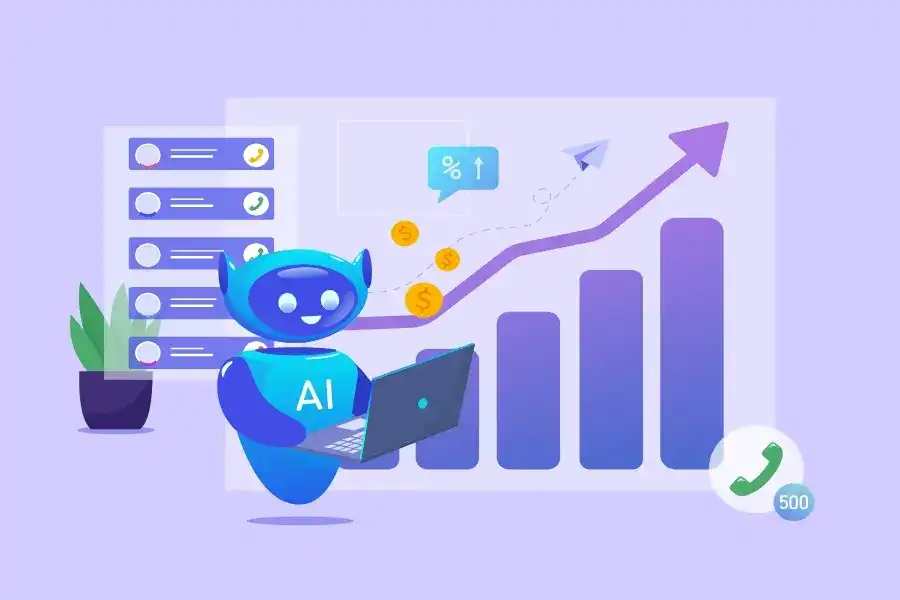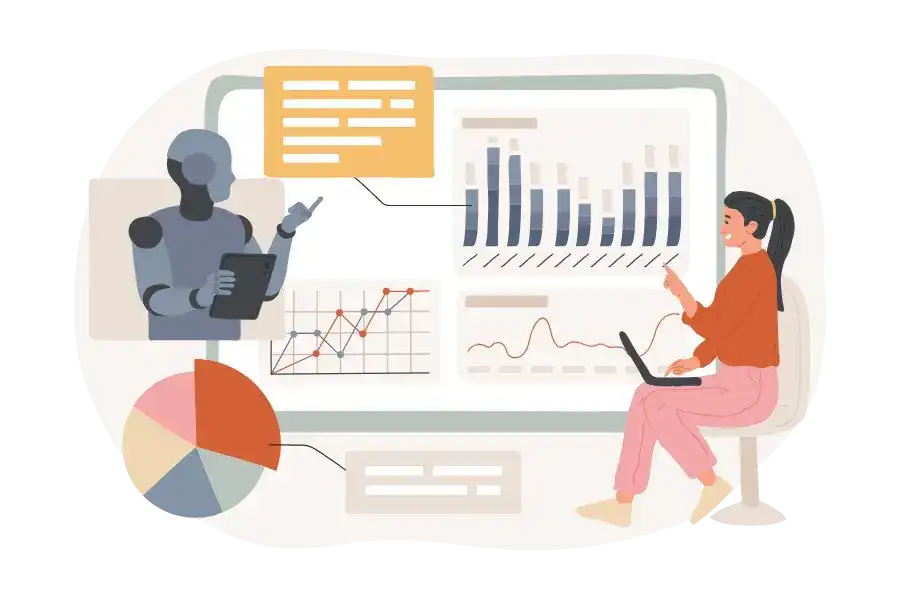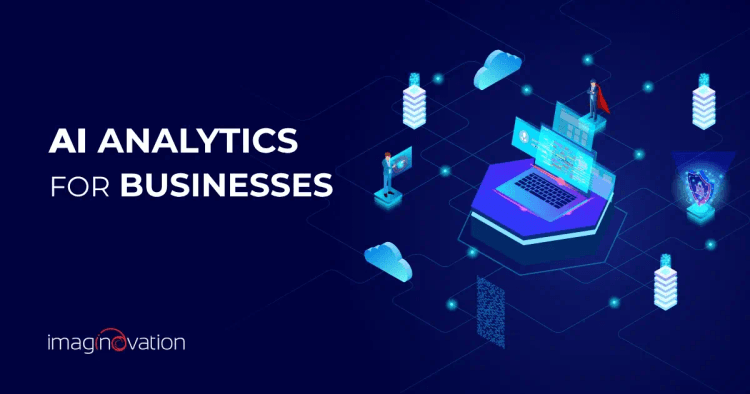In a business world that never slows down, making fast and informed decisions is crucial. That’s where AI Analytics comes in. It can help organizations turn complex data into clear, actionable insights when they need them most. Artificial Intelligence bridges the gap between human decision-making and machine-driven intelligence.
According to projections, the AI market will reach $184 billion in 2024 to $826.7 billion by 2030, growing at a compound annual growth rate (CAGR) of 28.46%. (Source)
AI brings immense advantages, transforming how businesses operate. The time is ripe for leaders to harness the power of AI in business analytics. In this article, we’ll uncover the benefits, real-world examples, and much more.
Let’s dive in!
AI Analytics: Revolutionizing Business Decision-Making
It's exciting to see the corporate world fully embracing the AI shift. But what is it that gives AI its decisive, game-changing edge?
Let's find out.
1. Handles Complex Datasets
Handling complex data can be challenging, especially when extracting business value. Traditional methods often require hours of manual work to extract and prepare data for analysis and visualization.
Enter AI Analytics—a game-changer that processes massive, intricate datasets using advanced machine learning and deep learning techniques that outperform conventional tools. It automates data extraction, cleaning, and preparation and delivers real-time insights that predict trends and recommend the best action.
Unlike traditional tools, AI seamlessly works with structured and unstructured data, continuously learning and improving. With its speed, scalability, and actionable intelligence, AI analytics empowers businesses to make smarter, faster decisions. It gives companies the competitive edge they need to thrive in today's digital economy.
2. Uncovers hidden patterns and correlations
Imagine a retail company using AI to analyze customer data. On the surface, traditional analytics might reveal basic patterns, like higher sales during the holiday season. However, AI goes deeper, identifying hidden correlations between customer purchase behavior and external factors like social media activity, weather conditions, or even economic indicators.
For instance, AI might uncover that customers in a particular region will likely buy a specific product when bundled with another item but only when advertised after 6 PM on weekdays.
Additionally, AI might detect a hidden trend where specific customers are more responsive to promotions during rainy days, leading to targeted marketing strategies.
These nuanced insights, which would be difficult or impossible to detect with traditional tools, allow the retailer to fine-tune their marketing and inventory decisions for maximum impact.
3. A shift from predictive to prescriptive analytics
The transition from descriptive to predictive and prescriptive analytics is reshaping the way businesses approach decision-making. Descriptive analytics looks back, summarizing past events, while predictive analytics takes it further by forecasting future trends using data patterns.
However, the real game-changer is prescriptive analytics, which predicts outcomes and suggests the best actions. This transformation empowers businesses to move from simply reacting to past data to making more thoughtful, proactive decisions. It’s about being in control and driving greater efficiency, and staying ahead of the competition.
Bottomline: AI Analytics is revolutionizing how organizations unlock insights, transforming hidden data into a significant competitive advantage.
Key Benefits of AI Analytics for Businesses

AI analytics can supercharge your business's operational efficiency. Here are some key benefits.
1. Personalization
With AI analytics, you can create tailor-made experiences for your customers, delivering personalized recommendations and content that truly resonate. By analyzing customer behavior and preferences, businesses can send targeted marketing messages, boost engagement, and build stronger relationships, ultimately driving sales.
2. Data-Driven Decision Making
At the heart of AI analytics, business leaders will find insights to help make informed decisions. Thus, no more does one have to rely on gut instincts.
Organizations have a wealth of trends and insights backed by leveraging real-time data analysis that guide strategic choices. This approach reduces uncertainty, allowing leaders to back their decisions with solid evidence and adapt quickly to market demands.
3. Predictive Analytics
A standout feature of AI analytics is its predictive capabilities, enabling businesses to foresee future trends and outcomes.
When you find historical data, you can employ AI models, which can help accurately forecast market shifts, customer behavior, and potential risks. This foresight allows organizations to optimize inventory, refine marketing strategies, and enhance customer service, driving growth and improving overall performance.
4. Fraud Detection and Security
AI-driven analytics strengthens fraud detection and security by applying sophisticated algorithms to analyze large volumes of transactional data in real time. It will help with getting immediate access to suspicious patterns and anomalies. Thus, one can respond quickly to potential threats with such ready insights.
This proactive approach minimizes financial losses and protects customer data while AI systems continuously learn and adapt to evolving fraud tactics, ensuring a safer environment for businesses and their customers.
5. Versatile Data Analysis
AI analytics offers versatile data analysis, allowing businesses to process and analyze diverse data types from various sources. It will be easy for you to interpret both structured data that may come from databases and unstructured data that may come from social media.
The spread helps businesses get insights from multiple data points, offering a comprehensive view of operations and customer behavior, which in turn helps make better decisions and create targeted strategies.
6. Equipment Fault Detection
AI analytics transforms equipment fault detection using advanced algorithms to monitor machinery and sensors in real-time. This technology quickly identifies anomalies that signal potential failures, enabling timely interventions.
By catching faults early, businesses can reduce unexpected breakdowns, minimize costly downtime, and optimize maintenance schedules. As AI learns from historical data, it becomes increasingly effective at predicting and diagnosing equipment issues, enhancing operational reliability, and driving significant cost savings.
Also Read: IoT Data Analytics: Types, Applications, and Implementation Guide
Real-World Use Cases of AI Analytics

1. Healthcare
AI analytics in health has helped diagnostics, support drug discovery, enhance personalized medicine and telemedicine, and more. Yet another area where AI benefits healthcare is its use in predictive analytics. The insights help improve patient outcomes and early disease detection.
Let's look at a good example—the Johns Hopkins Hospital developed an AI-powered system called the Sepsis Prediction Algorithm (SPA). This system continuously analyzes a wide range of real-time patient data to identify patterns and subtle changes in a patient's condition, predicting sepsis up to 12 hours earlier than traditional methods. Early detection allows healthcare providers to intervene sooner, significantly improving patient outcomes and reducing mortality rates.
Thus, AI analytics can enhance patient care and help hospitals reduce ICU stays and costs while improving overall efficiency in resource allocation.
2. Customer Service
AI analytics is changing the face of customer service by boosting efficiency, personalization, and overall customer satisfaction. AI analytics helps businesses analyze vast amounts of customer data, which allows tailored customer service. The data may include past preferences, interactions, and purchasing history.
Let's look at a good example—Zendesk uses AI analytics to assess the tone and urgency of customer messages, automatically prioritizing critical issues and directing them to the right team. Another good example is that AI-powered chatbots like IBM Watson Assistant use analytics to answer frequently asked questions and resolve common issues instantly, reducing wait times and freeing up human agents for more complex tasks.
3. Finance
A real-world example of AI analytics benefiting the finance industry is its use in fraud detection and prevention.
A good example is AI-Powered Fraud Detection at JPMorgan Chase. One of the largest banks in the world, JPMorgan Chase, uses AI analytics to detect and prevent fraudulent activities. It developed an AI-powered system that monitors millions of transactions, spotting irregularities that human analysts might miss.
The system uses machine learning models, which support looking at the historical data and improving its accuracy over time. Imagine, if an unusual spending pattern gets detected on a customer's credit card—for instance, a large international purchase when the customer typically shops locally—in such scenarios, the AI system flags it for review or automatically blocks the transaction.
4. Manufacturing
A real-world example of AI analytics working well for the manufacturing industry is its application in predictive maintenance.
Let's look at a good example—Siemens, a global manufacturing and industrial automation leader, uses AI analytics to enhance equipment maintenance through its MindSphere platform, a cloud-based IoT operating system. By deploying AI-powered predictive maintenance solutions, Siemens monitors the performance of machinery in real time, collecting data from sensors embedded in equipment across its manufacturing plants.
Siemens' use of AI-driven predictive maintenance has led to significant improvements in operational efficiency, extending the lifespan of machinery, reducing maintenance costs, and optimizing production schedules. This proactive approach keeps manufacturing lines running smoothly and prevents disruptions, increasing productivity and cost savings.
5. Agriculture
A real-world example of AI analytics that supports agriculture is its use in precision farming to optimize crop yields.
For example—John Deere, a leading agricultural machinery manufacturer, has integrated AI analytics into its farming equipment to help farmers make data-driven decisions. John Deere uses machine learning and data analytics to analyze real-time data collected from sensors, satellites, and drones deployed on farms through its AI-powered precision agriculture platform.
John Deere's See & Spray technology adopts AI analytics, which helps to identify weeds among crops in real-time. The system analyzes imagery from the field and distinguishes weeds from crops, enabling farmers to apply herbicides only where necessary, rather than spraying entire fields. This helps cut down the chemicals that get used. Plus, it can help lower costs and minimize environmental impact.
6. Education
A real-world example of AI analytics benefiting education is its use in personalized learning and student performance prediction.
For example, Arizona State University (ASU) uses AI analytics to improve student outcomes through its adaptive learning platform Knewton. The platform leverages AI analytics to analyze individual students' learning patterns, strengths, weaknesses, and progress. Based on this data, it personalizes the content and pace of learning for each student, ensuring that they receive the suitable materials and exercises at the right time.
Preparing for AI Analytics Implementation
Let's explore some essential factors to consider when preparing for AI analytics implementation.
1. Ensure Data Quality and Readiness
The success of AI-powered analytics hinges on one critical foundation—clean, structured data. Without high-quality data, even the most advanced AI models will struggle to deliver accurate insights.
Thus, businesses must ensure that their data is well-organized, error-free, and consistently updated. Investing in data cleansing and preparation is not just a technical necessity, but the key to unlocking the full potential of AI analytics.
It is a critical step, and you can think of it as laying the groundwork for reliable and actionable insights that drive informed decision-making.
2. Set Clear Objectives
Before diving into AI analytics, defining clear business objectives is essential. It will help you brainstorm with the team and collate the specific areas or pain points you wish AI to solve. Whether it's improving customer retention, optimizing supply chains, or detecting fraud, having a well-defined goal helps guide the AI implementation process.
Without a focused objective, businesses risk wasting resources on solutions that don't directly address their most pressing challenges. Companies can align their analytics strategy with long-term success by pinpointing the areas where AI can make the most significant impact.
3. Hire AI Talent or Upskill
Yet another significant factor when it comes to implementing AI analytics is having the right talent. Businesses must decide whether to utilize their existing workforce, upskill current employees, or hire specialized AI talent.
Upskilling existing staff in AI tools and techniques can foster internal growth and leverage their industry knowledge, while hiring external experts can accelerate AI adoption with cutting-edge expertise. Striking the right balance between upskilling and recruiting ensures your team can handle AI's technical demands while integrating it seamlessly into your operations.
4. Embrace Change Management
When adopting AI analytics, you know it isn't just a technological shift—it's a cultural one, too. For AI to be truly effective, company-wide buy-in is essential. From leadership to front-line employees, everyone must understand AI's value and how it aligns with the organization's goals.
This requires transparent communication, continuous education, and an openness to change. By fostering a culture that embraces AI, businesses can overcome resistance and ensure that AI analytics drives innovation and efficiency across the organization.
Implementing AI Analytics: A Step-by-Step Guide
Let's look at some steps that can help you implement AI analytics.
1. Defining Objectives
The first starting point will be to identify clear business goals. Brainstorm to find out the problems that you wish to address. Also, think of the insights that you want to gain.
2. Collecting and Preparing Data
Once you have well-defined objectives. You can start by gathering relevant data from various sources (structured and unstructured). The stage is suitable for cleansing the data, which you can do by removing duplicates, outliers, and missing values. Next, look at organizing data in a consistent format.
3. Choosing the Right Tools and Platforms
At this stage, you can select AI analytics tools like TensorFlow, PyTorch, or cloud platforms (AWS, Azure). The right tools and platforms will support the delivery of the best outcomes. Thus, it is essential to consider the selection of tools and platforms before implementation. You must ensure scalability, integration with existing systems, and data security.
4. Building Data Models
After selecting the tools, you can start building data models. You may use machine learning (ML) algorithms or deep learning models tailored to your objectives. You must also train the model using historical data and test it to ensure accuracy.
5. Analyzing Data
Once you build your data models, it is time to run your AI model on current data to generate insights. You can consider using descriptive, predictive, or prescriptive analytics based on your needs.
6. Visualizing and Interpreting Results
At this stage, you can start implementing dashboards or visual tools to present the data clearly (e.g., Power BI, Tableau). You can share actionable insights with stakeholders in an understandable format.
7. Deploying and Integrating
It is vital to plan the deployment; you may need to embed the AI analytics into your workflows or business processes for this stage. You must also ensure it's easy to use and accessible to key decision-makers.
8. Monitoring and Improving
Post-deployment, you may wish to monitor the performance of your AI models continuously. Yet another essential aspect is to update algorithms and retrain models regularly as new data comes in.
9. Ensuring Compliance and Ethics
One crucial aspect you can take care of is staying aligned with data privacy regulations (e.g., GDPR). You must also be transparent in how AI makes decisions, ensuring fairness and eliminating bias.
10. Scaling
Finally, as your needs grow, scale AI capabilities to handle larger datasets and more complex analyses. You can explore automation for real-time data analytics.
This guide will help you harness AI analytics for data-driven decision-making.
Unlock the Power of AI Analytics with Imaginovation
Discover the possibilities of AI analytics by teaming up with Imaginovation, an award-winning web and mobile app development company in the US. With our deep expertise in cutting-edge technology, we'll help you turn your data into actionable insights that can elevate your business.
Our custom solutions are designed to boost performance, fuel smarter decisions, and deliver measurable ROI. Ready to take your business to the next level?
Let's make it happen together!
Ready to build an app, but not sure where to start?
We've got you covered. Click the button below to get started.





